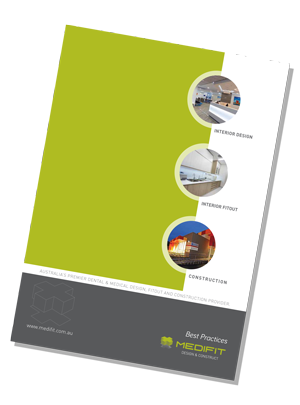Radiation protection still a must in dental practice
By Geoffrey A Raphael
Design Director - Medifit Design & Construct
This article was published in 2004 in Australasian Dental Practice
The reduced radiation levels required to expose the latest fast-speed x-ray films and digital x-ray sensors are reassuring to patients, however, dentists and practice staff should not become complacent and ignore safety precautions.
X-rays have a cumulative effect in the body and levels rise over time from even mild frequent exposure.
When moving or renovating your practice, x-ray shielding requirements need to be addressed to ensure x-rays are contained within the treatment or OPG room and do not penetrate, for example, into the reception area that may be on the other side of the wall, or even the tenancy in the office next door.
One of the key reasons to use specialist dental design and construction companies when considering building or refitting your practice is that they should be up-todate with all the current, pending and future requirements in this area.
Radiation shielding is a hidden safety net that is often ignored or taken for granted. Few understand the technicalities of protecting yourself, your team and your patient and like body protected electrical circuits, there are no nationally regulated guidelines at this stage. Each states’ regulation varies from no requirement at all to individual design and certification for each room.
The International Commission on Radiological Protection has set the following limits on exposure to ionizing radiation.
- The general Public shall not be exposed to more than 1 mSv per annum (over and above natural background); and
- Occupational exposure shall not exceed 20 mSv per annum.
Table 1. gives you an idea of sources and resulting exposure to ionizing radiation.
| Table 1. Typical exposure to ionizing radiation | |
|
Natural Radiation (Terrestrial and Airborne) |
1.2 mSv per year |
| Seven hour aeroplane flight Average dosage Chest x-ray Nuclear Fallout (from atmospheric tests in 50’s & 60’s) Chernobyl (People living in control zones near Chernobyl) Average Cosmic Radiation Exposure of Domestic Airline Pilot |
0.05mSv |
| Risk of Cancer from 1mSv of radiation (Age standardised lifetime for whole population) Normal incidence of same (Not necessarily fatal) |
1 in 17,000 |
Without getting into scatter and secondary beams, which is a whole other discussion, radiation examination is generally classified into four types: Intraoral, Occlusal, Panoramic and Cephalometric. Each type has differing levels of radiation and exposure and hence differing levels of protection required. Public areas and corridors adjacent to the x-ray source may also require shielding to ensure the safety of people passing or waiting. The type and method of protection itself can vary from simply ‘adding’ another layer of gyprock sheeting to the walls through to 1.2mm thick steel sheeting within the wall itself or even a layer of lead sheeting. This requirements vary greatly dependant on many operatory variance factors and variances from state to state.
Design layout in the treatment room plays a factor in the type of shielding needed with generally a 270-degree radius around the patients’ head taken as the primary beam of radiation from an in-chair x-ray, with the patients’ feet being clear. With this in mind, it would make sense to point the foot of the chair towards where the x-ray operator stands to ensure they are outside the radiation zone. This isn’t always ideal for taking advantage of that great view out the window and having your patients’ feet facing the doorway can be off-putting as well as being ergonomically incorrect for patient movement in and out of the treatment room.
Regulation-wise, South Australian standards are by far the easiest to comply with. They have a set of blanket rules regulated and enforced by the Environmental Protection Agency - Radiation Protection Division. They call for the equivalent of 1mm sheet steel from 300mm above floor level to 1.8m above the floor level. The shielding is required in a 270-degree arc balanced and centred on the patients’ head. The operator of the x-ray should either be standing in an area not exposed to the primary beam or be sufficiently shielded while still retaining a view to the patient; 20mm plate glass is required for any viewing windows. The compact information sheet for compliance is readily available and compliance is easily attained in most cases.
Across the border in Victoria there are no intra-oral x-ray shielding requirements that we know of. OP/Ceph locations do require shielding.
Queensland, New South Wales and Western Australia have comprehensive radiation safety and protection guidelines and licensing requirements for Intra- and Extra-oral equipment and procedures. A registered radiological consultant must individually design each treatment room or OPG location. Whilst some states have different governing bodies regulating the individual requirements, the certification process is similar.
The actual costs to install adequate radiation shielding during the practice renovation process are negligible, particularly when compared with retrofitting at a later date. Careful treatment room planning is key as well as an understanding of the above requirements and likelihood of any future inclusions.
With patient and staff safety being a concern for every practice and what will soon be national regulated standards on radiation shielding, the time invested now for potential refits or new surgery rooms could save health problems, future liabilities and costly retro fitting in the future.

